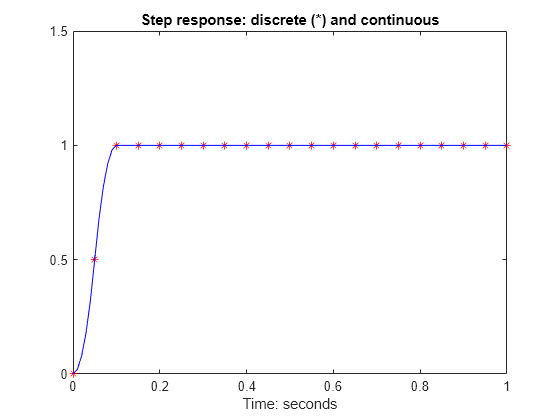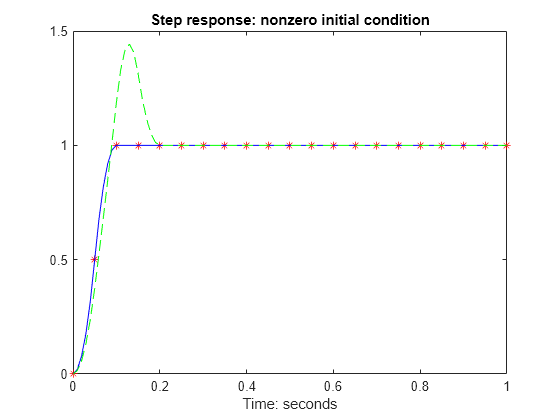sdlsim
Time response of sampled-data feedback system
Syntax
sdlsim(p,k,w,t,tf) sdlsim(p,k,w,t,tf,x0,z0) sdlsim(p,k,w,t,tf,x0,z0,int) [vt,yt,ut,t] = sdlsim(p,k,w,t,tf) [vt,yt,ut,t] = sdlsim(p,k,w,t,tf,x0,z0,int)
Description
sdlsim(p,k,w,t,tf) plots the time response of the hybrid feedback system. lft(p,k), is forced by the continuous input signal described by w and t (values and times, as in lsim). p must be a continuous-time LTI system, and k must be discrete-time LTI system with a specified sample time (the unspecified sample time –1 is not allowed). The final time is specified with tf.
sdlsim(p,k,w,t,tf,x0,z0) specifies the initial state vector x0 of p, and z0 of k, at time t(1).
sdlsim(p,k,w,t,tf,x0,z0,int) specifies the continuous-time integration step size int. sdlsim forces int = (k.Ts)/N int where N>4 is an integer. If any of these optional arguments is omitted, or passed as empty matrices, then default values are used. The default value for x0 and z0 is zero. Nonzero initial conditions are allowed for p (and/or k) only if p (and/or k) is an ss object.
If p and/or k is an LTI array with consistent array dimensions, then the time simulation is performed pointwise across the array dimensions.
[vt,yt,ut,t] = sdlsim(p,k,w,t,tf) computes the continuous-time response of the hybrid feedback system lft(p,k) forced by the continuous input signal defined by w and t (values and times, as in lsim). p must be a continuous-time system, and k must be discrete-time, with a specified sample time (the unspecified sample time –1 is not allowed). The final time is specified with tf. The outputs vt, yt and ut are 2-by-1 cell arrays: in each the first entry is a time vector, and the second entry is the signal values. Stored in this manner, the signal vt is plotted by using one of the following commands:
plot(vt{1},vt{2})
plot(vt{:})
Signals yt and ut are respectively the input to k and output of k.
If p and/or k are LTI arrays with consistent array dimensions, then the time simulation is performed pointwise across the array dimensions. The outputs are 2-by-1-by-array dimension cell arrays. All responses can be plotted simultaneously, for example, plot(vt).
[vt,yt,ut,t] = sdlsim(p,k,w,t,tf,x0,z0,int) The optional arguments are int (integration step size), x0 (initial condition for p), and z0 (initial condition for k). sdlsim forces int = (k.Ts)/N, where N>4 is an integer. If any of these arguments is omitted, or passed as empty matrices, then default values are used. The default value for x0 and z0 is zero. Nonzero initial conditions are allowed for p (and/or k) only if p (and/or k) is an ss object.
Examples
Algorithms
sdlsim oversamples the continuous-time, N times the sample rate of the controller k.
Version History
Introduced before R2006a


